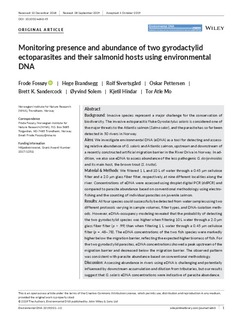Monitoring presence and abundance of two gyrodactylid ectoparasites and their salmonid hosts using environmental DNA
Fossøy, Frode; Brandsegg, Hege; Sivertsgård, Rolf; Pettersen, Oskar; Sandercock, Brett K.; Solem, Øyvind; Hindar, Kjetil; Mo, Tor Atle
Peer reviewed, Journal article

Åpne
Permanent lenke
http://hdl.handle.net/11250/2628700Utgivelsesdato
2019Metadata
Vis full innførselSamlinger
- Scientific publications [1392]
Originalversjon
10.1002/edn3.45Sammendrag
Background: Invasive species represent a major challenge for the conservation of
biodiversity. The invasive ectoparasitic fluke Gyrodactylus salaris is considered one of
the major threats to the Atlantic salmon (Salmo salar), and the parasite has so far been
detected in 50 rivers in Norway.
Aims: We investigate environmental DNA (eDNA) as a tool for detecting and assessing
relative abundance of G. salaris and Atlantic salmon, upstream and downstream of
a recently constructed artificial migration barrier in the River Driva in Norway. In addition,
we also use eDNA to assess abundance of the less pathogenic G. derjavinoides
and its main host, the brown trout (S. trutta).
Material & Methods: We filtered 1 L and 10 L of water through a 0.45 μm cellulose
filter and a 2.0 μm glass fiber filter, respectively, at nine different localities along the
river. Concentrations of eDNA were assessed using droplet digital PCR (ddPCR) and
compared to parasite abundance based on conventional methodology using electrofishing
and the counting of individual parasites on juvenile salmon.
Results: All four species could successfully be detected from water samples using two
different protocols varying in sample volumes, filter types, and DNA‐isolation methods.
However, eDNA‐occupancy modeling revealed that the probability of detecting
the two gyrodactylid species was higher when filtering 10 L water through a 2.0 μm
glass fiber filter (p > .99) than when filtering 1 L water through a 0.45 μm cellulose
filter (p = .48–.78). The eDNA concentrations of the two fish species were markedly
higher below the migration barrier, reflecting the expected higher biomass of fish. For
the two gyrodactylid parasites, eDNA concentrations showed a peak upstream of the
migration barrier and decreased below the migration barrier. The observed pattern
was consistent with parasite abundance based on conventional methodology.
Discussion: Assessing abundance in rivers using eDNA is challenging and potentially
influenced by downstream accumulation and dilution from tributaries, but our results
suggest that G. salaris eDNA concentrations were indicative of parasite abundance.
Conclusion: We conclude that eDNA is an efficient way of monitoring gyrodactylid
parasites and their salmonid hosts, and we suggest that eDNA should be incorporated
into future monitoring of G. salaris.
